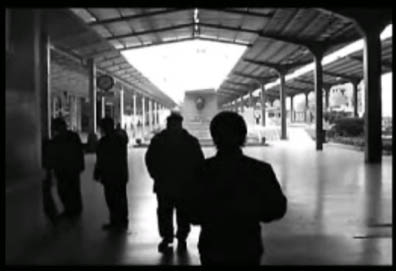As iphone fever overwhelms the electronic toy collectors, we all need to get serious about a future without privacy or distance in the classic sense. We remain tethered to everyone: lovers, friends, strangers and computer generated messages. What excuse do we have to cut ourselves off and take a break?
I am sure that many, many artists have been making works for cell phones for a while, but this week I discovered the Festival of Pocket Films held in Paris in early June 2007 for the third year. All the video was shot with a cell phone and designed to playback on the cell phone. Below are a few that I liked with the link to the video. Start with Tic Tac Toe by Matthew Swanson of Vancouver, Canada for a little smile.
The tiny video works that interest me contradict the notion of constant connection and communications. These videos grab moments in the city when we are private in our heads despite our full immersion in urbanity. Is this the future? Even with some private territory in an apartment, will only mental privacy survive in the megacities? When the cell phone provides an avenue for almost anyone to enter your space, are these short mental moments of isolation the new reality of intimacy?
Reserve Love and Free Run capture the joy of movement among urban streets. One is a brisk walk toward a meeting with a lover in Paris. The other is an imaginary run and jump and skate with the flow of the city of London at all scales. Joy makes the world feel like an out-of-focus river. The world is present but never with you.
Brother and Sorrow capture moments of pain in the city when a person is self-isolated in sadness or depression. Background people move in mass, but the single character does not interact and attempts to remain motionless while moving. Unlike joy, in sadness all the little details of the place receive a linering, focused observation.
All the works are developed for the cell phone – the instrument of connection. But these films are viewed when the phone itself is used to make a private moment. A short break of intense consentration on a tiny image. The destroyer of traditional privacy has the capacity to encourage the new privacy of living inside your head.
Free Run by Henry Reichhold, UK
Imaginary run through London with the city flying by.
“Reverse Love” Still
Reverse Love by Morgan Foldi-Mohand
Pleasant view of the ourselves enjoying the street with private music
Brother by Kerim Bersaner, The Netherlands
The narrator describes his pain of the loss of a brother while images of Chechnya’s destruction and of her mothers move in a crowd or alone in the street.

Sorrow Still (Istanbul Train Station)
Sorrow: D’A.Betil, D. Buga, O. Karaglu, Turkey
Private internal space or sorrow while riding the train and ferry
These two works below I highlight for the flattening of space: literally and in the Thomas Friedman world. Tracking Transience takes you around the world in 120 seconds with a generic urbanity, maps, urinals where only the plates of food spark any locality, (yet these plates are available in any city with immigrant restaurants.) Carscapes turns San Paulo into any concrete city and with uncongested freeways during part of the day.
Tracking Transience by Hasan Elahi, USA
Tour the world in 120 seconds with streets, food and urinals
Carscapes by Giselle Beiguelman, Brazil
Fast clips of urban San Paulo from the car window
Public Art, Public Space

The planet becomes microscopic. I am not sure that any of the people I deal with connected to the digital world or to the Internet are real. They’re more like ephemeral ghosts whose voices come and go and fade away and even the echo of them does not resonante. The mistake is in assuming the meaningless and muffled cacophony is the world. It’s not. There is hordes and hordes and hordes and hordes — I see it on my travels from a numbing distance — and they’re not connected. They’re impoverished and scraping by in every way and they work hard and wear rags and they are almost starving and mainly on their knees and humanity is a slave. They’re superstitious, ill, plagued, rotting like a carcass; they cling by their fingernails to the rhetoric of family and “values,” and they either live in a garbage heap or close enough to one. “Family” is still the unit and the cave is not that far away. The problem is that we all can’t fit into the cave but it’s there. Mainly what “they” do is live long enough to reproduce. They see the smaller world, the electronic one, the digital one, the affluent one, the one with tiny phones, and technology, the one that sees them in return as potential consumers. Technology is not necessarily hope. Perhaps hope for a few. “They” want a piece of that action. Who wouldn’t. Many like the one I see in Africa, not just the Sudan, but Africa are glad to not have been slaughtered at the end of the day. A few are getting “to technology” but they are tokens. So we might assume (wrongly) those tokens are everywhere. It’s the slavery that is the shapeshifter. Human slavery to something or someone or someones or someone else’s agenda is still most of the world. What the technology is really doing is providing the people who control it with tools to serve urbanity an illusion and it works. Urbanity’s poverty is their lostness in the illusion (that the world has fundamentally changed) and they are truly lost. Lost is not connected. It is only lost.